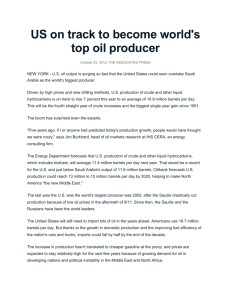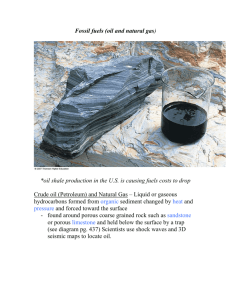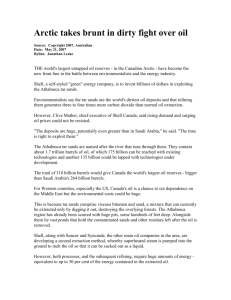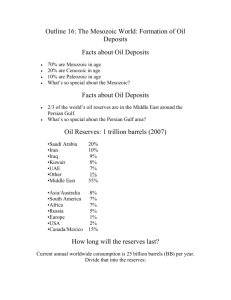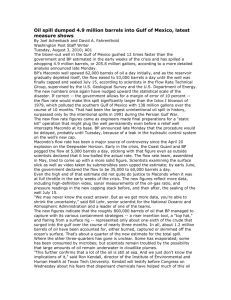National Geographic - University of Colorado Boulder
advertisement
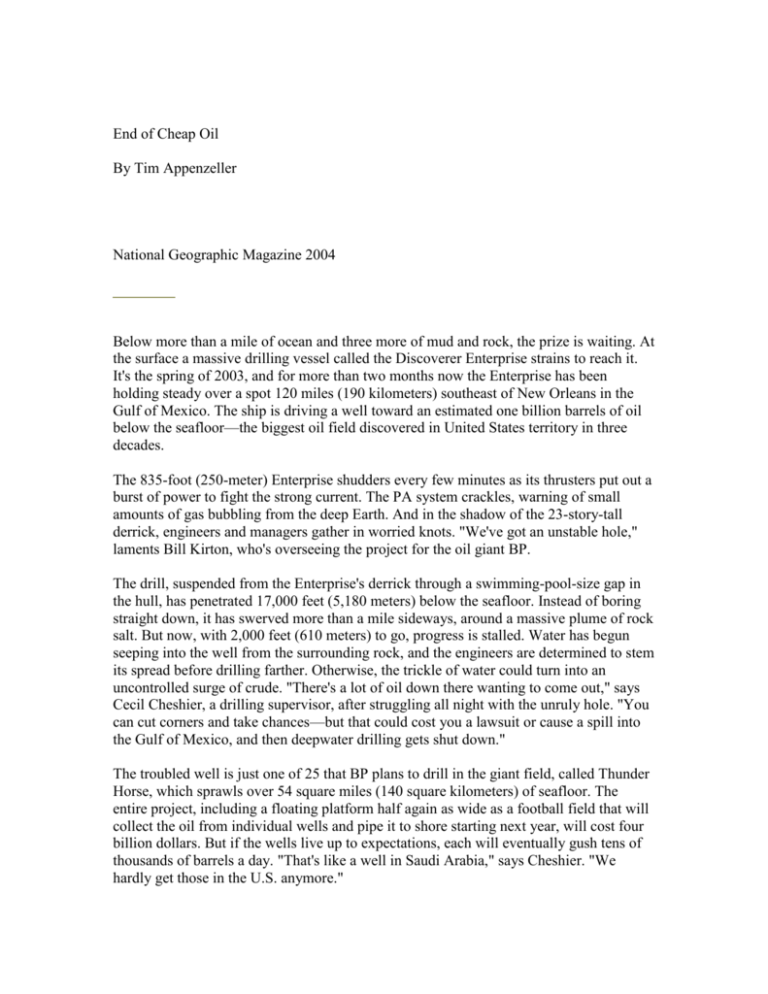
End of Cheap Oil By Tim Appenzeller National Geographic Magazine 2004 Below more than a mile of ocean and three more of mud and rock, the prize is waiting. At the surface a massive drilling vessel called the Discoverer Enterprise strains to reach it. It's the spring of 2003, and for more than two months now the Enterprise has been holding steady over a spot 120 miles (190 kilometers) southeast of New Orleans in the Gulf of Mexico. The ship is driving a well toward an estimated one billion barrels of oil below the seafloor—the biggest oil field discovered in United States territory in three decades. The 835-foot (250-meter) Enterprise shudders every few minutes as its thrusters put out a burst of power to fight the strong current. The PA system crackles, warning of small amounts of gas bubbling from the deep Earth. And in the shadow of the 23-story-tall derrick, engineers and managers gather in worried knots. "We've got an unstable hole," laments Bill Kirton, who's overseeing the project for the oil giant BP. The drill, suspended from the Enterprise's derrick through a swimming-pool-size gap in the hull, has penetrated 17,000 feet (5,180 meters) below the seafloor. Instead of boring straight down, it has swerved more than a mile sideways, around a massive plume of rock salt. But now, with 2,000 feet (610 meters) to go, progress is stalled. Water has begun seeping into the well from the surrounding rock, and the engineers are determined to stem its spread before drilling farther. Otherwise, the trickle of water could turn into an uncontrolled surge of crude. "There's a lot of oil down there wanting to come out," says Cecil Cheshier, a drilling supervisor, after struggling all night with the unruly hole. "You can cut corners and take chances—but that could cost you a lawsuit or cause a spill into the Gulf of Mexico, and then deepwater drilling gets shut down." The troubled well is just one of 25 that BP plans to drill in the giant field, called Thunder Horse, which sprawls over 54 square miles (140 square kilometers) of seafloor. The entire project, including a floating platform half again as wide as a football field that will collect the oil from individual wells and pipe it to shore starting next year, will cost four billion dollars. But if the wells live up to expectations, each will eventually gush tens of thousands of barrels a day. "That's like a well in Saudi Arabia," says Cheshier. "We hardly get those in the U.S. anymore." You wouldn't know it from the hulking SUVs and traffic-clogged freeways of the United States, but we're in the twilight of plentiful oil. There's no global shortage yet; far from it. The world can still produce so much crude that the current price of about $30 for a 42gallon barrel would plummet if the Organization of the Petroleum Exporting Countries (OPEC) did not limit production. This abundance of oil means, for now, that oil is cheap. In the United States, where gasoline taxes average 43 cents a gallon (instead of dollars, as in Europe and Japan), a gallon of gasoline can be cheaper than a bottle of water—making it too cheap for most people to bother conserving. While oil demand is up everywhere, the U.S. remains the king of consumers, slurping up a quarter of the world's oil—about three gallons a person every day—even though it has just 5 percent of the population. Yet as the Enterprise drillers know, slaking the world's oil thirst is harder than it used to be. The old sources can't be counted on anymore. On land the lower 48 states of the U.S. are tapped out, producing less than half the oil they did at their peak in 1970. Production from the North Slope of Alaska and the North Sea of Europe, burgeoning oil regions 20 years ago, is in decline. Unrest in Venezuela and Nigeria threatens the flow of oil. The Middle East remains the mother lode of crude, but war and instability underscore the perils of depending on that region. And so oil companies are searching for new supplies and braving high costs, both human and economic. Making gambles like Thunder Horse and venturing into West Africa and Russia, they are still finding oil in quantities to gladden a Hummer owner's heart. But in the end the quest for more cheap oil will prove a losing game: Not just because oil consumption imposes severe costs on the environment, health, and taxpayers, but also because the world's oil addiction is hastening a day of reckoning. Humanity's way of life is on a collision course with geology—with the stark fact that the Earth holds a finite supply of oil. The flood of crude from fields around the world will ultimately top out, then dwindle. It could be 5 years from now or 30: No one knows for sure, and geologists and economists are embroiled in debate about just when the "oil peak" will be upon us. But few doubt that it is coming. "In our lifetime," says economist Robert K. Kaufmann of Boston University, who is 46, "we will have to deal with a peak in the supply of cheap oil." The peak will be a watershed moment, marking the change from an increasing supply of cheap oil to a dwindling supply of expensive oil. Some experts foresee dire consequences: shortages, price spikes, economic disruption, and a desperate push to wrest oil from "unconventional" sources such as tar sands, oil shale, or coal. Others think that by curbing our oil use and developing sustainable alternatives now, we can delay the peak and wean ourselves more easily when the inevitable happens. "There are many things you can do to ease the transition," says Alfred Cavallo, an energy consultant in Princeton, New Jersey. "And you can have a very nice life on a sustainable system. Of course, not everyone is going to be driving SUVs." The stuff we pump into our gas tanks is a freak of geology, the product of a series of lucky breaks over millions of years. The first break came in a life-rich ancient sea: Sediments buried the organic material raining down onto the seafloor faster than it could decay. The next break: Eons later the seafloor sediments ended up at just the right depth—generally between 7,500 and 15,000 feet (2,280–4,570 meters)—for heat and pressure to slow-cook the organic material into oil. Then the oil collected in a "trap" of porous sandstone or limestone, and an impermeable cap of shale or salt kept it from escaping. Any gap in this lucky chain of happenstance means a dry hole today. The luck held often enough that the world can now feed a daily oil habit of nearly 80 million barrels. In the U.S. about two-thirds of the oil goes to make fuel for cars, trucks, and planes. But the synthetic fabrics in our wardrobe and the plastics in just about everything we touch started out as oil too. We can also thank oil and its cousin, natural gas, for the cheap and plentiful food at the supermarket, grown with the help of hydrocarbon-based fertilizers and pesticides. As Daniel Yergin writes in his oil history The Prize, we live in "the Age of Hydrocarbon Man." Around the world Hydrocarbon Man is getting thirstier. In the U.S., where oil consumption is expected to grow nearly 50 percent in 20 years, carmakers are touting horsepower as they did in the muscle-car 1960s. SUVs and minivans are displacing thriftier sedans and wagons as the standard family car. Even the tax code encourages consumption, offering people who buy the biggest SUVs for business use a deduction of up to $100,000. Since 1988 the average gas mileage of U.S. passenger vehicles has fallen, while the world has burned up more than a third of a trillion barrels of irreplaceable oil. China, too, is learning to drink deep. A decade ago the world's most populous nation sipped oil, its streets choked with bicycles rather than motorized traffic. But last year newly prosperous professionals snapped up over two million cars—up 70 percent over 2002. China may have already leapfrogged Japan to become the world's second largest oil user. By 2025 China could be using ten million barrels a day, most of which will come from outside its own borders. That's a predicament familiar to the U.S., where the roots of oil dependence deepened in the spring of 1971. Through 1970 the U.S. produced more than two-thirds of the oil it needed. An agency called the Texas Railroad Commission held down oil production to avoid overwhelming the market, keeping prices stable. By that spring, though, the giant, seemingly inexhaustible fields of Texas had reached their limits. The commission announced it would allow full-throttle production, but even so imports began rising—and the Texas fields just couldn't produce any faster. That became painfully clear two years later, when Arab leaders clamped an oil embargo on the U.S. in retaliation for Washington's support of Israel in the 1973 Mideast war. Fields at home could not make up the difference. Gas lines grew and prices soared, giving most Americans their first lesson in the fragility of oil supplies. The speed limit was dropped to 55 miles an hour to save fuel, and sales of thrifty Japanese and European cars surged. The 1978 revolution in Iran cut off that country's oil exports and triggered a second oil shock. By 1981 crude oil prices had risen above $70 a barrel in today's dollars, and U.S. oil consumption had dropped by nearly 15 percent from its 1978 peak. Higher prices also spurred the development of new fields outside the Persian Gulf: on Alaska's North Slope and in Mexico and the North Sea. The new fields increased the world's oil supply, and by the inevitable logic of the market, more supply and less demand led to a price collapse. By the mid-1980s oil was selling for less than $25 a barrel in today's dollars. OPEC's grip weakened, its share of the oil on the world market falling from 55 percent to 30 percent. And even though supply disruptions in Venezuela, Nigeria, and Iraq have pushed up prices, "the stuff is still dirt cheap," says Cavallo. It's so cheap that U.S. consumption has climbed 25 percent since the mid-1980s, to its highest level ever. Imports have surged to 54 percent of the country's oil needs. And the best hope for slowing the U.S. rise in dependence on imported oil lies far out at sea. To reach the deep waters of the Gulf of Mexico, where the tireless drillers aboard the Enterprise are wrestling with the balky well, you board a helicopter in the coastal flatlands of Louisiana and fly south, over the small oil platforms that have colonized the green shallows of the Gulf in the past 30 to 40 years. Like the fields on the U.S. mainland, they are in their twilight, their oil production slipping year by year. The platforms thin out and vanish by the time the ocean turns the blue of deep water, an hour from shore. Soon, another platform emerges from the haze. Called Marlin, it rides the waves on stout orange pontoons, its bright gas flare streaming in the breeze. Marlin is where BP engineers first learned to tap the Gulf's deepwater riches. Discovered in 1993, the Marlin field is now in full-scale production. Tethered to the bottom half a mile down by thick steel tendons, Marlin taps 48,000 barrels of oil a day from reservoirs two miles below the seafloor. Silvery ducts carry the crude to a complex of separator tanks. There natural gas, water, and sand are stripped out of the oil before it is pumped off the platform into a submerged pipeline, which carries it to shore. Geologists once doubted oil could be found this far from shore. Twenty years ago, as drilling marched seaward across the shallow continental shelf, the oil-bearing sandstone layer seemed to be petering out. Scientists concluded that the sand deposited tens of millions of years ago by great rivers had not spread all the way out on the shelf. But they were mistaken. The sand—and oil—was there all right. The sand had spilled off the edge of the shelf and down the steep continental slope to the deep-ocean floor. There it had pooled in apron-like deposits that turned into porous rock—perfect for capturing oil oozing from still deeper rock layers. In the 1990s, as hints of these deposits began showing up in seismic data, the vanguard of oil production stepped off the continental shelf, into waters thousands of feet deep. Now giant new fields, the biggest of them Thunder Horse, beckon at 6,000 feet (1,800 meters) and more. At still greater depths approaching 10,000 feet (3,048 meters), says geophysicist Roger Anderson of Columbia University, "there have been a whole series of finds," although they have yet to be exploited. All in all, oil experts estimate that the deep waters of the Gulf of Mexico will yield more than 25 billion barrels of oil. That's twice as much as in Alaska's giant Prudhoe Bay field, and far more than in any untapped U.S. prospect, including the controversial Arctic National Wildlife Refuge. "There's a major consensus that there's more oil there than you'd ever find in ANWR," says Anderson. With the boost from deepwater wells, offshore oil should increase from a third of U.S. oil production now to more than 40 percent by 2008, before tapering off. But it will still barely ease the American thirst for oil. On the other side of the Atlantic, just off the coast of Cameroon, in West Africa, a giant pipeline terminal is helping quench that thirst. Every few days a tanker departs from the terminal with a belly full of oil piped 665 miles (1,070 kilometers) through savanna and rain forest from the billion-barrel Doba fields in Chad. The oil began flowing in July 2003, much of it bound for the United States. At 3.7 billion dollars, the project is the biggest private-sector investment in sub-Saharan Africa—a measure of U.S. interest in the 30 billion to 50 billion barrels of oil trapped in and near the Gulf of Guinea. A swelling river of crude from Chad, Nigeria, Angola, and other African countries now makes up 15 percent of U.S. imports and is expected to rise. The Chad-Cameroon pipeline is more than another assurance that U.S. gas stations won't run short. It's also an effort by the World Bank and an industry consortium led by ExxonMobil to reverse the mounting human costs of oil development in Africa. So far, says Terry Lynn Karl, a Stanford University political scientist, the track record is "about as bleak as you can get." By fueling inflation and dreams of quick wealth, she says, oil revenue has withered Africa's oil economies. In Nigeria the proportion of the population living in severe poverty has more than doubled, to 66 percent, after three decades of oil production. Oil revenues have vanished from national treasuries and into the pockets of corrupt officials in staggering amounts—over four billion dollars since 1997 in Angola, for example. "Oil has had a tendency to erode the democratic institutions that did exist," says Ian Gary of the Catholic Relief Services, who co-authored a study of African oil development with Karl. And oil money has often fed the region's many civil wars. Eager to avoid such problems in Chad, ExxonMobil enlisted the World Bank to ensure that the country's government spends its oil windfalls on its people. The bank insisted that Chad set up an independent committee to manage its new riches—109 million dollars or more this year—reserving most of it for infrastructure, education, and health. The bank also monitored the pipeline construction and arranged compensation for farmers along the route. But to Karl the arrangement has "loopholes you can drive a supertanker through," and Chad's government got off to a spectacularly bad start when it spent 4.5 million dollars— of a 25-million-dollar initial bonus from the oil companies—on weapons. Yet Columbia University law professor Peter Rosenblum believes the agreement is an important step. "As much as there's foreboding and fear about what's going to happen, there's also a recognition that this has put into place meaningful ground rules." In Africa, oil's corrosive effects are metaphorical. In Kazakhstan, another frontier in the oil scramble, the crude itself is literally corrosive. The Central Asian land east of the Caspian Sea boasts the biggest single discovery in 30 years: a vast geologic trap extending beneath the Caspian, called the Kashagan field, that could yield seven billion to thirteen billion barrels as it's developed. But it won't be easy. Its oil is under high pressure and laced with poisonous hydrogen sulfide, which requires special equipment and handling. And the field lies in the northern Caspian, a stronghold of the endangered beluga sturgeon, in waters too shallow for ordinary ships and oil platforms. In the 1990s the first glimpse of fields like Kashagan spurred talk that the Caspian might be a new Middle East, with reserves of hundreds of billions of barrels. But the promising geologic structures did not always hold oil. More sober assessments now put the Caspian's promise at 17 billion to 33 billion barrels. The real challenge to the Middle East's oil dominance comes from elsewhere in the old Soviet Union: the boggy, cold forest of western Siberia. Once the bulwark of the Soviet oil industry, Siberia declined in the early 1990s as its wells and infrastructure fell into disrepair. Many analysts believed Siberia's oil was played out. Now it's making a comeback. Russia passed Saudi Arabia in 2003 as the world's biggest producer. And, says Matt Sagers, a Russia expert at Cambridge Energy Research Associates, "for Russia it's still up, up, and away." That's because the rough-and-tumble private companies that grabbed the Soviet fields at fire-sale prices in the early 1990s have gotten serious about modernizing them. Enlisting Western specialists, the companies resurveyed the fields with up-to-date seismic technology to determine where the oil was hiding and how best to get it out. They shut down unpromising wells and coaxed more out of others by hydraulic fracturing: driving high-pressure fluids down the wells to break up the rock and open new escape routes for the crude. "We went in and developed the fields the way ExxonMobil or ChevronTexaco would have done and are getting [production] increases of 20 percent a year," says Ray Leonard, an American oilman and a vice president of Yukos, one of Russia's two largest oil companies. Russia is pumping nearly nine million barrels a day and exporting about two-thirds of it. Production would be even higher if Russia only had enough pipelines to get the oil to its borders. Says Eugene Khartukov, director of the Moscow-based Center for Petroleum Business Studies: "If the export routes are opened, the oil will fly like a cork from a bottle of ex-Soviet champagne." But struggles between the oil companies and Russia's government, which owns the pipelines, have slowed the construction of new routes to an ice-free port in the west and to China and Japan, eager customers. And the jailing for alleged fraud and tax evasion of former Yukos boss Mikhail Khodorkovsky, a billionaire with political ambitions, has scared off foreign investors who could bankroll further upgrading of the fields. Even so, Russia's output is drawing uneasy glances from OPEC. A surge of Russian oil could undercut the cartel's effort to adjust its production to hold world oil prices between $22 and $28 a barrel. Leonard puts Russian reserves at around 100 billion barrels. Other experts say the companies haven't explored enough to know. Either way, even Russia has its limits, as Leonard acknowledges. He thinks Russia's oil output will crest in 10 to 15 years, putting OPEC firmly in control of prices again. "Around the middle of the next decade, the price of oil is going to go up and stay up," he says. If it does, an unusual kind of oil that exists far from the Middle East will become more alluring. You can get a glimpse of it just north of Fort McMurray, a former fur-trading outpost in the Canadian province of Alberta. Just where the highway crosses the Athabasca River, veins of black, tarry sand streak the riverbanks. On a hot day tar sand is sticky and smells like fresh asphalt—the smell of money the locals call it. No wonder they're smug. The tar-sand deposits here and elsewhere in Alberta hold the equivalent of more than 1.6 trillion barrels of oil—an amount that may exceed the world's remaining reserves of ordinary crude. But this is no ordinary crude. In fact, it's a residue created when conventional oil escaped from its birthplace deep in the Earth's crust and was degraded into tar by groundwater and bacteria. Most of the tar sand lies too deep or in deposits too sparse to be exploited. But oil-sand companies got a boost in the 1990s as technology improved and Canada cut the first few years of the royalties that companies were required to pay. The Alberta government reckons that 174 billion barrels could now be tapped economically. Last year the U.S. Department of Energy agreed and included that number in Canada's proven reserves. The move catapulted Canada to second place in the ranking of oil-rich states, right behind Saudi Arabia—and ahead of Iraq, Iran, and Kuwait. But standing at the edge of a 200-foot-deep (60-meter-deep) pit where giant electric- and diesel-powered shovels devour beds of oil sand, Shell Canada Senior Vice President Neil Camarta acknowledges that there's a big difference between the oil-sand riches and freeflowing crude. "It's not like the oil in Saudi Arabia. You see all the work we have to do; it doesn't just jump out of the ground." Shell's is one of three big operations that together wring more than 600,000 barrels of oil a day from the Athabasca sands. Every step of the way takes brute force. The sand has to be strip-mined, two tons of it for each barrel of oil. Dump trucks the size of mini-mansions haul 400 tons in a single load, in beds heated during the subarctic winters so the sand doesn't freeze into a giant blob. Next to the mine, the sand goes into the equivalent of giant washing machines, where torrents of warm water and solvent rinse out the tar, or bitumen, leaving wet sand that is dumped in tailing ponds. Even then the bitumen is not ready to be piped off to a refinery like ordinary crude. To turn it back into crude oil, the operations either cook it in cokers, where temperatures of 900°F (500°C) break up the giant tar molecules, or heat it to lower temperatures and churn it with hydrogen gas and a catalyst. The result is a clean, low-sulfur crude— "beautiful stuff," says Camarta. But producing it is not so pretty, he acknowledges. "This really is a big, big project," Camarta says of Shell's four-billion-dollar mine and plant, which opened last year. "It has a big footprint too, and we don't hide that—a big environmental and a big social imprint." Other oil-sand operations have left the land north of Fort McMurray pocked with mines and lakes of sludgy gray tailings. So far less than 20 percent of the disturbed land has been restored to grassland and forest. Dust, diesel exhaust, and sulfurous fumes pollute the air. It takes three barrels of water to extract each barrel of bitumen, and although the plants are careful to recycle water, they still draw heavily on the Athabasca River. Heating all that water takes vast amounts of natural gas. Worried about Canada's dwindling natural gas supplies, Alberta has even considered someday building a nuclear reactor smack in the tar-sands region to supply power and steam. The local First Nations people—Canada's Native Americans—mourn the loss of once pristine land. In the village of Fort McKay seven miles from Shell's mine, the company paid to build a community center on the poplar-clad banks of the Athabasca. Seated by a soaring fireplace bearing a Shell plaque, Chief Jim Boucher, president of the Athabasca Tribal Council, acknowledges that development has brought jobs and money. But the chief, who grew up trapping mink, muskrat, and beaver in intact forest, says: "In people's minds, what's going on is too much. We're losing too much of our land. The amount of destruction, especially in the minds of the elders, is horrendous." Unless oil prices collapse, the destruction is likely to continue. With tar-sand production costs down to about ten dollars a barrel, the operations expect to make a handsome profit. Existing mines are expanding, and more companies are jumping in. Some are starting to exploit tar sands too deep to be mined, by forcing high-pressure steam down wells to melt out the bitumen. Production could reach two million barrels a day in a decade, according to the Alberta government. That may be a comfort when the other up-and-coming oil fields of today start to dwindle, from the Gulf of Mexico to Russia. But the tar sands won't be enough to stave off new dependence on the volatile Middle East. The U.S. government's Energy Information Administration projects that in 20 years, the Persian Gulf will supply between one-half and two-thirds of the oil on the world market—the same percentage as before the 1973 embargo. Fifty years later, in other words, the Middle East will have regained all its old power over oil—and the U.S. government knows it. Whether or not Washington's war in Iraq was directly motivated by oil, American planners clearly hoped it would lay the groundwork for a stable, democratic Middle East—which, among other benefits, would in Washington's view put the world's oil supply in more trustworthy hands. Yet the real threat to the world economy 20 years from now may not be the policies of the Middle East. It may be a global shortage of conventional oil. These days a raging debate divides oil experts, with prophets of imminent shortage pitted against believers in at least a couple more decades of abundance. Pessimists note that oil prospectors had their best luck in the early 1960s, and that discoveries have slowed since then. They conclude that little conventional oil is left to be found and that the oil peak could be upon us by 2010. Optimists call that a naive extrapolation, which overlooks the economic and political factors that drive the search for oil. "People who are predicting an imminent peak are simply wrong," says Boston University's Kaufmann. The argument ultimately depends on how much oil is left in the world's biggest wellspring of crude, the Middle East. With nearly two-thirds of proven conventional reserves, Middle Eastern lands will be the supply of last resort as oil production declines elsewhere. "We take it for granted that they'll come forth with whatever volume of oil is needed to balance supply and demand," says Robert Ebel, head of the energy program at the Center for Strategic and International Studies, a Washington think tank. Maybe not for long, says Matthew Simmons, president of the Houston energy-investment advisory bank Simmons and Company. He notes that Saudi Arabia, "the one country that we always assumed had fabulous reserves," hasn't found a big new field for decades. And in Saudi technical reports he sees hints of trouble: When water starts coming up a well, its productive life is over—and that's starting to happen in Saudi fields. If he's right, even the Middle East may fall short of growing demand sooner than expected. On the optimistic side, the United States Geological Survey (USGS) concluded in a 2000 study that there's at least 50 percent more oil left than the pessimists believe, much of it in the Middle East. New technologies will wring additional supplies from existing fields, the USGS predicts, and vast new reserves remain to be found. Many economists agree, saying discoveries have fallen off simply because countries awash in oil like Iraq, Iran, and Saudi Arabia have had no incentive to drill for more. "If I'm an OPEC producer, with lots of spare capacity, why would I waste money looking for more reserves?" asks Kaufmann. But in the end, "you're talking about a few years one way or another," says Cavallo, the Princeton consultant. Thomas Ahlbrandt, the geologist who led the USGS study, says that even the larger reserves he envisions can't sustain the world's growing thirst for oil indefinitely. "Oil and gas are limited," he says flatly. "My personal feeling is, we have a concern in the next couple of decades." Either way, the crude won't suddenly dry up: Old oil fields don't die, they slowly fade away. But the world will face shortages more lasting than any 1970s oil shock—and some stark choices. Should we increase production from the Canadian tar sands and similar "heavy oil" deposits in Venezuela? Try to exploit the American West's vast deposits of oil shale and other organic-rich rock that yields oil when roasted? Both options carry heavy environmental costs. Or should we pin our hopes on finding new supplies of natural gas, extracting fuel from plant material, or building solar, wind, or nuclear plants to make hydrogen for fuel-cell vehicles? There are no easy options, and all will take time to explore. Aboard the Enterprise drill ship in the deep Gulf, engineers and roughnecks are doing their best to postpone the day of reckoning. By the summer of 2003 they had brought the well under control and finished it, 15 million dollars over budget and a month behind schedule. "We did fight that well for a little while," says BP's Kirton wryly. Now they've moved on to other holes, laboring on a drilling floor slick with fluids while the ship battles the current and the bit gnaws through salt, shale, and sandstone toward the geologic legacy that fuels our way of life. But at least some of the ingenuity and toil that goes into getting oil needs to go toward limiting our thirst for it. "People should be doing something now to reduce oil dependence and not waiting for Mother Nature to slap them in the face," says Cavallo. With every visit to the gas pump, after all, the end of cheap oil draws closer.


